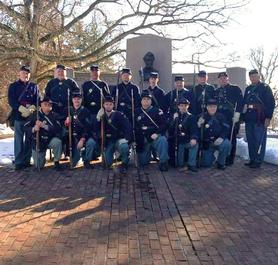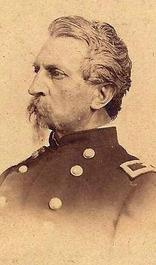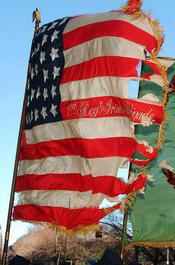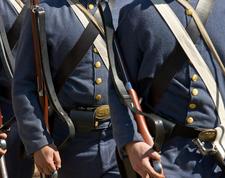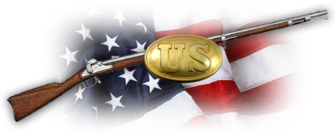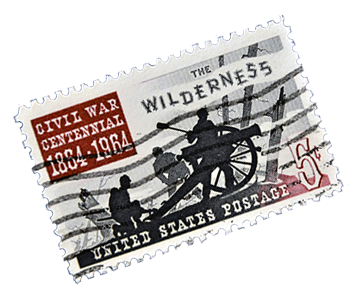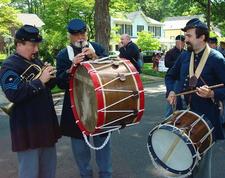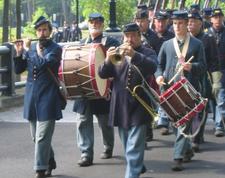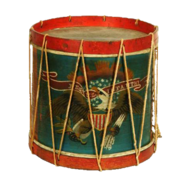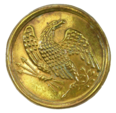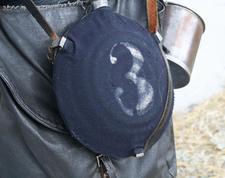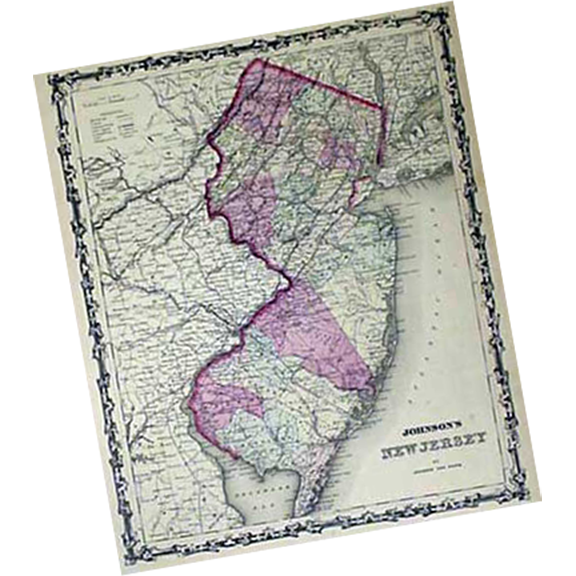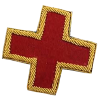1-908-377-7148
History of The 3rd NJ Volunteer Infantry
 | ||||
In April 1861, the Third New Jersey Volunteer Infantry was formed. Third was organized under the authority of General Orders No. 15, War Department, Adjutant General's Office, Washington, D.C, May 4, 1861. The Regiment was fully organized, equipped, and officered by the 18th day of May, and on June 4th was duly mustered into service of the United States for 3 years at Fort Olden, Trenton, N.J. It left the state on June 28, 1861 with a full compliment of men, as follows: Officers- 38, Non-Commisioned Officers and Privates- 1013, totaling 1051. Company A was commanded by Captain Henry W. Brown, who briefly served in that capacity from May 23, to May 31 1861. He was succeeded by Captain David Vickers, Jr. Colonel George W. Taylor was appointed to command the Third Regiment, New Jersey Volunteer Infantry. His Lieutenant Colonel was none other than Henry W. Brown. The First New Jersey Brigade was lead by Brigadier General Philip Kearny. Just before that time (August 1861) the First, Second, and Third New Jersey Volunteer Infantry, and the ninety day militia men ( later replaced by the 4th New Jersey Volunteers) were known as the Fourth Division under General Theodore Runyon. This division was part of the Army of Northeast Virginia lead by Major General Irvin McDowell.
In 1862, Company A was still commanded by Captain David Vickers Jr. Colonel Taylor remained the regiments commander until May 9, 1862. He was succeeded by Lt. Colonel Henry W. Brown.
At about the same time, the Brigade was officially designated the First Brigade, First Division, Sixth Corps. Brigadier General Philip Kearny relinquished command on May 9, 1862 in order to assume command of a division in the Third Corps. Kearny was succeeded by George W. Taylor, who was promoted to Brigadier General. Taylor commanded the First New Jersey Brigade until his death on August 31, 1862. It was not until November 1862 that Brigadier General Alfred T.A. Torbert ( who was mustereing officer when the Third Regiment was formed) was appointed to lead the Brigade.
Until the First New Jersey Brigade was officially designated as the First Brigade , First Division, it was known simply as a part of Franklin's Division. When it was designated the First Division, the Division was under command of William B. Franklin until May 1862 when Henry W. Slocum took command. The Brigade remained part of the First Army Corps under McDowell and the Department of the Potomac until May 1862, when it became the Sixth Corps (under Franklin), Army of the Potomac under McClellan. McClellan was replaced by Major General Ambrose Burnside in November 1862. Burnside remained in command of the Army of the Potomac for the remainder of the year and into 1863. in late 1862, the First Division was reorganized as a part of the Left Grand Division under William B. Franklin. After the debacle at Fredericksburg, the Grand Division organization was abandoned and the Division reverted to the First Division under Major General William Brooks who commanded until June 1863.
About the Original 3rd NJ Volunteer Infantry
The Regimental Fife and Drum Corps
The Regimental Fife and Drum Corps
Fifes and drums have been used together for martial duties since the 14th century. It was not until the American Revolution that fife and drum bands were widely organized and used by both sides for field calls and entertainment. Fifes and drums grew to be military necessities during the time between the Revolution and the Civil War. With the firing on Fort Sumter and the start of the Civil War, the mass raising of regiments also called for the need to recruit large numbers of musicians. Schools of instruction were begun on Bedloe's and Governors Islands in New York Harbor for field musicians of the Army of the Potomac. The training was rigorous, as each fifer and drummer was required to know and perform the numerous duties and calls from memory.
The Instruments
The fifes were six holed, and tuned to B flat. They were usually wood- rosewood or cocobolo being most common, but some metal fifes were used as well. Fifes have a capacity of playing three octaves, but were generally played in the 2nd and 3rd, though the music was written in the first and second octaves.
The Drums used by musicians of the Civil War were rope tension, unlike the modern rod tension. They were also larger and deeper, which allowed more of a roar which could be heard over large distances and over tremendous noise- perfect for a battlefield. Standard field drums were 16" in diameter, and 12" in depth. The heads were calfskin, and the snares were animal gut. The shells were made of ash, and were usually painted to signify the branch of service- blue for infantry, red for artillery, etc., and sometimes decorated with a patriotic eagle. The counterhoops were painted crimson red.
In 1863, Company A remained under the command of Captain David Vickers Jr., until September 29, 1863, when Captain Vickers resigned. He was succeeded by Captain John L. W. Wench, formerly a Sergeant. Colonel Henery W. Brown continued as the regiment's commander. His Lt. Colonel was the former Major Stickney. The Brigade was still commanded by Brigadier General Alfred T. A. Torbert. While part of the Left Grand Division, William H. F. "Baldy" Smith commanded the Sixth Corps, while Franklin commanded the Left Grand Division. Major General Horatio Wright assumed command of the Division in June 1863 and served in that capacity during the Gettysburg campaign until May 1864. The Sixth Corps was commanded by Franklin and later Smith, under Major General John Sedgwick assumed command of the Corps that spring of 1863. The Army of the Potomac, seemingly a revolving door, saw three commanding generals in the space of a few months. Burnside was replaced in March 1863 by Major General Joseph Hooker. Hooker only lasted a few months until he was replaced in June 1863 by Major General George Meade. Meade remained the commanding general of the Army of the Potomac for the duration of the war.
In 1864, Captain John L. Wench continued in command of Company A until June 23, 1864 when he was mustered out of service. The regiment was commanded by Colonel Henry W. Borwn until the regiments enlistments expired and the Third was official mustered out. Under the Provisions of General Order 191, War Department, Adjutanat General's Office, Washington D.C., June 25, 1863, members re-enlisted in the field for three more years, or the duration of the war. Those who did not re-enlist were mustered outof service in Trenton, N.J. by William N. Tisdall, 1st Lieutenant 1st Infantry, U.S. Army on June 28, 1864. Alfred Tordert relinquished command of the Brigade in April 1864 when he was promoted to a division command under Major General Philip Sheridan. Torbert was succeeded as Brigade Commander by Colonel William Penrose of the 15th New Jersey Regiment. Horation G. Wright commanded the First Division until May 1864. He was succeeded by David Russell who served until September 1864 when he was killed at Opequon. Emory Upto assumed temporary command of the Division until Frank Wheaton was formally appointed in October 1864. Wheaton served as the Division commander for the duration of the war. The Sixth Corps was commanded by John Sedwick until his death at Spotsylvania on May 9, 1864. He was succeeded by Horatio G. Wright, who remained the Corps commander for the duration of the war. As previously noted, George G. Meade commanded the Army of the Potomac from 1863 for the duration of the war.
When enlistments for the Third New Jersey Volunteer Infantry expired in June 1864, those who had chosen to stay, as well as those whose terms with the Regiment had not expired were temporarily assigned to duty with the 15th Regiment, and so remained until December 17, 1864, when they were consolidated into what was known as Company A, 3rd Battalion, 1865 by Major A.M. Tyler, Assistant Commissary of Muster's First Division, Sixth Army Corps, under the provision of Special Orders, No. 158, Headquarters, Army of the Potomac. Those in 15th New Jersey Volunteer Infantry were commanded by Lieutenant Colonel Edward C. Campbell and saw action in the valley campaign leading up to the battle at Cedar Creek. Men of the Third fought in every major battle of the eastern theatre of the Civil War.
3rd New Jersey Civil War Reenactors

